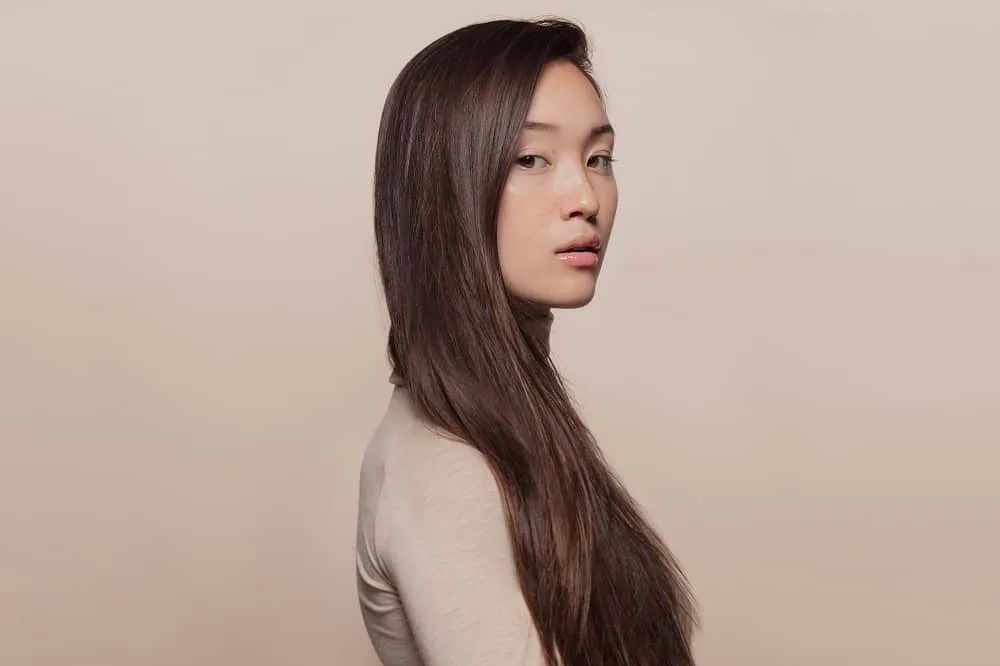Our hair defines us. Hair might not be the first of the characteristics we think of when picturing friends, family, or others, but it does play a large part in making us who we are.
Are you interested in learning more about Asian hair vs. Caucasian hair? Let’s dig dive. The story of two hair types and two ethnic populations is just the beginning. Our hair tells an exhilarating tale about our backgrounds, our present, and where we’ll go in the future.
Let’s take a closer look at the differences between Asian hair and Caucasian hair. Perhaps you’ll discover something new about yourself. Or maybe we’ll learn how much we share in common between ethnic groups!
Hair 101: Looking Closer At Hair And Ethnicity

As much as we dye, cut, curl, or shave our hair, there’s no escaping the hair we were born with. It’s a central element of the inheritance we received from our families and ethnic groups thousands of years ago.
Under the microscope, human hair has 8-10 distinct properties. Scientists and ethnographers can isolate these properties and use them to put hair types into categories.
Putting people and their hair types in categories is not a harmless thing, though. Categories can lead to stereotypes and even discrimination.
Read more on the recent controversy about hair discrimination for more information.
What are the elements of our hair that these scientists study? The main ones are:
- Cuticle layers
- Cross-sectional area (width of each hair strand)
- Hair curvature
- Hair straightness
- Pigmentation (nature color)
- Hair growth rate
- Hydration content
So, we’ll have to zoom in on each of these categories to get more insight into the differences between Asian hair and Caucasian hair. For now, it’s enough to say that the two hair types present some striking differences in their properties.
Characteristics Of Asian Hair
Some Asian hair might look similar to Caucasian hair. Generally, Asian hair is darkly pigmented or black and straight with a shiny surface.
The two hair types share a long history, as Asian and Caucasian populations have lived near each other for centuries.
Ever think about the two words “Asian” and “Caucasian”? The words are closely related, and the two regions that they refer to are too. The Caucasus area is located in Asia, too, between the Black Sea and the Caspian Sea.
But Asian hair has unique characteristics not shared with Caucasian hair. Let’s look at the main features.
Cuticle Layering

Everyone’s hair is structurally the same. Cuticles are the protective layers that surround our hairs (often five to ten layers per hair). The more cuticles, the thicker and wider the hair.
Asian hair has, on average, twice the number of cuticles as Caucasian hair. Most Caucasians have five layers of cuticles per hair, while Asians have 10. So, Asian hair looks thicker and more compact on the scalp than Caucasian hair.
Cross-Sectional Area Of The Hair
Scientists also measure the diameter of hair fibers for each ethnic group. Asian hair is wider, and it lays down on the scalp with a much “fuller” look than Caucasian hair.
It’s actually the widest hair type of the three (caucasian, African, and Asian) that scientists research!
If you’ve ever noticed how full and healthy Asian hair can look on the head, it’s probably because of the diameter or area that each strand covers.
Curvature And Straightness
Asian hair isn’t only wide on a cross-sectional measurement. In general, Asian hair is quite round, straight, and cylindrical when cut in two. Asian hair is rarely curly, but it is not unprecedented.
Hair straightness and curvature vary widely between individuals. According to a study, it is one of the most diverse of our body’s unique features. Even more, reason to be proud of the variety of our body types!
Pigmentation

Asian hair is primarily dark-pigmented. Why? Dark hair has higher levels of a pigment called eumelanin, and lighter hair (like blond or red hair occurring in caucasian gene pools) has less.
Asian hair is darker than Caucasians simply because high eumelanin content runs in Asian families. Another thing: Asian hair tends to grow darker with age, up to a point.
Hair Growth Rate
Compared to Caucasian hair and African hair, Asian hair displays the fastest growth rate. About 1.4 cm per month, on average. Both people with straight and semi-straight Asian hair reported similar growth rates.
Hydration Level
Hydration is also a measure of the number of fats or lipids that make up one’s hair. Among ethnic groups, Asian hair is less hydrated than Caucasian hair. The two hydration levels can lead to some remarkable differences in how the hair fibers act.
For one, Asian hair tends to break off from the scalp in one large strand. Caucasian hair is more fragile, and it tends to break into small pieces.
Characteristics Of Caucasian Hair

Now that we understand what makes Asian hair so unique, let’s compare it to Caucasian hair. There are a few main points to mention.
- Caucasian hair has about half the amount of cuticles per strand.
- On a cross-section, Caucasian hair is thinner, more fragile, and oval than Asian hair’s cylindrical profile. Therefore, white people’s hair is thinner.
- Caucasian hair displays a much wider variety of curves. Curly or wavy, and straight hair are just three types.
- Pigments are also more numerous for Caucasian hair. Anywhere from white-blonde to dark brown and black is common.
- Caucasian hair grows at a rate of 1.2 cm per month, about 30% slower.
- Caucasian hair has more fat or hydration levels per strand.
Asian Hair Vs. Caucasian Hair
|
Asian Hair |
Caucasian Hair | |
|
Cuticle Layering | 10 layers per strand | 5 cuticle layers per strand |
| Curvature/Straightness | More often straight |
Wider variety |
|
Pigmentation |
Most often black |
Varied |
|
Growth Rate |
1.5cm per month |
1.2cm per month |
|
Hydration Level |
Less |
More |
FAQs
Above, we covered the main differences between Asian hair and Caucasian hair. But surely there are some last-minute questions. We’ve assembled an FAQ section to answer them.
Asian hair has a much better history of reacting positively to hair loss plans. Consequently, Asian hair provides the majority of the world’s hair for wigs and hair extensions!
Scientists observe that balding patterns occur less frequently in Asian hair than in caucasian hair. Caucasian hair also falls out more often during the day.
A few tips to help manage frizzy, difficult Asian hair are:
● Brush your hair before washing
● Take cooler showers
● Choose anti-frizz shampoos with argan oil and coconut oil
● Add hair oils to tame thick hair
Caucasian hair is just as prone to frizz and other problems as Asian hair. Try this:
● Cut back on shampoos to once a week
● Pick a gentler brush
● Skip the conditioner for your scalp
● Don’t tie back your hair too tightly
In Summary
Our hair defines us, but it’s still up to us how we manage and style it. It’s fascinating to learn more about our ethnic background and the origin of our hair. But we can make our hair do miraculous things, and we can make our own story too.
Asian hair is darker, glossier, thicker, and less fragile than Caucasian hair. In turn, Caucasian hair is more hydrated, more diversely colored, and curlier. But as we know from this article, those descriptions are just the beginning of our hair story!
You May Also Like
